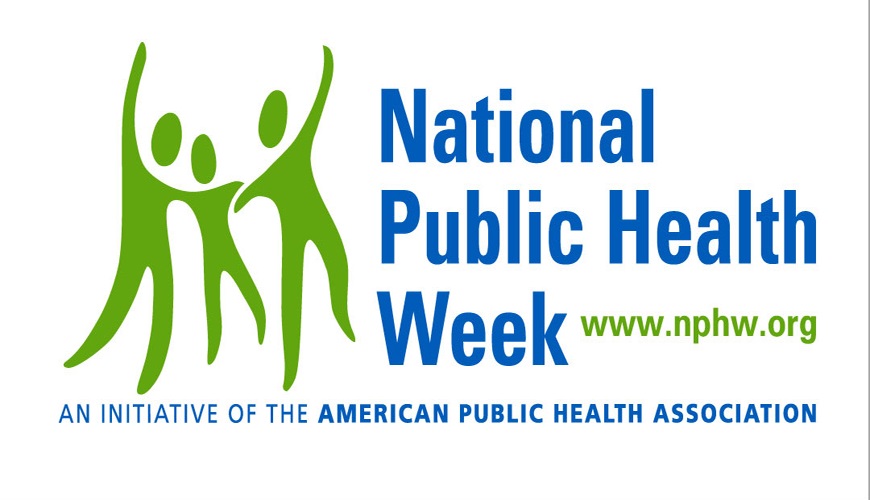
Observed during the first full week of April each year, National Public Health Week was created to celebrate the field of public health and its advances, but it’s also a way to raise awareness of the current health issues of our time. This year’s National Public Health Week theme, “Healthiest Nation 2030: Changing Our Future Together,” is a call to make the United States the healthiest nation in one generation by 2030.
What is public health?
Whether you realize it or not, public health is all around us.
It’s the appropriately handled and cooked steak at your favorite restaurant. It’s the vaccine you took to prevent a disease. It’s the epidemiologist who discovers the source of an E-coli outbreak. It’s the outreach program that advocates for healthier families and infants. It’s the banner you see at a football game that helps prevent tobacco and drug use.
Public health, founded on the principle that everyone should have the right to good health, looks at the well-being of the community. It researches the risk of disease and injury in a population and then takes the necessary action to prevent them before they occur.
Public health achievements
According to the Centers for Disease Control and Prevention (CDC), public health is credited with adding 25 years to the life expectancy of people in the United States. Successes in public health have controlled the spread of infectious diseases, raised cancer prevention awareness, and drastically lowered the infant mortality rate.
As we celebrate National Public Health Week, here’s the CDC’s ten greatest public health achievements of the 20th century.
1. Immunizations. At the beginning of the 20th century, infectious diseases such as smallpox, measles, diphtheria, and pertussis (whooping cough) were prevalent. Because of vaccines, smallpox has since been eradicated and measles can be prevented with the MMR (measles, mumps, and rubella) vaccine… MORE.
2. Motor-Vehicle Safety. Six times as many people drive today as in 1925, and the number of motor vehicles in the country has increased 11-fold since then to approximately 215 million. Despite the steep increase in motor-vehicle travel, the annual death rate has decreased 90 percent… MORE.
3. Workplace Safety. Data from the CDC shows that the number of work-related deaths between 1933 and 1997 decreased from 14,500 to 5,100, yet the workforce during this same period more than tripled, from 39 million to approximately 130 million…MORE.
4. Control of Infectious Diseases. In 1900, the three leading causes of death were pneumonia, tuberculosis (TB), and diarrhea and enteritis, whereas in 1997, 4.5 percent of deaths were attributed to pneumonia, influenza, and HIV…MORE.
5. Declines in Deaths from Heart Disease and Stroke. Heart disease has been the leading cause of death in the United States since 1921, and for much of the 20th century stroke was the third leading cause of death. Since 1950, however, age-adjusted death rates from cardiovascular disease have declined 60 percent…MORE.
6. Safer and Healthier Foods. During the 20th century, contaminated food, milk, and water caused many foodborne infections, such as typhoid fever, tuberculosis, botulism, and scarlet fever. Once the sources and characteristics of foodborne diseases were identified, they could be controlled by sanitation, refrigeration, pasteurization, and pesticide application. In 1900, the incidence of typhoid fever was approximately 100 per 100,000. By 1950 that number decreased to 1.7 per 100,000...MORE.
7. Healthier Mothers and Babies. At the beginning of the 20th century, for every 1000 live births, six to nine women in the United States died of pregnancy-related complications, and approximately 100 infants died before age 1. In 2014, the infant mortality rate declined more than 90 percent to 5.82 per 1000 live births...MORE.
8. Family Planning. When people can control how many children they want to have, and when, healthier infants, children, and women tend to be the result. In 1900, the average family size was 3.5 children. The modern birth control movement began in 1912, and by 1933 the average family size dipped to 2.3 children...MORE.
9. Fluoridation of Drinking Water. Extensive dental caries (tooth decay) was common at the beginning of the 20th century. No effective measures existed for preventing the disease, and the most frequent treatment was tooth extraction. However, through clinical observation it was concluded that higher fluoride levels correlated with a decline in dental caries…MORE.
10. Tobacco as a Health Hazard. During the first portion of the 20th century, lung cancer was rare, but as cigarette smoking became more prevalent, the incidences of lung cancer became epidemic. In 1964, a Surgeon General report stated that “cigarette smoking is a health hazard of significance importance.” Substantial public health efforts to reduce the use of tobacco began shortly after the report. Despite the achievements and advances to curb smoking the last several decades, approximately 20 percent of adults smoke, and tobacco use is responsible for roughly 430,000 deaths every year…MORE.
Public health challenges
While there have been many great achievements and advances in public health, there are still many challenges that lie ahead. Food safety, proper nutrition, physical activity, obesity, teen pregnancy, tobacco use, and prescription drug overdose are all issues facing the United States. (To see Tennessee’s data concerning public health problems click HERE.)
Public health agencies and officials will continue to monitor these issues, and others -- all working to make your neighborhood, community, city, state, and world a healthier place.
Remember, public health isn’t just when you hear on the news how a food outbreak was contained, it’s also the food outbreak that never happened. Public health is everywhere.



Click here to leave a comment or concern.